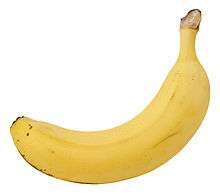Masak Hijau banana
Masak Hijau bananas are triploid banana cultivars from Malaysia. It is a member of the commercially important Cavendish banana subgroup.[1] It is a popular banana cultivar in Southeast Asia and the West Indies.[2][3]
| Musa acuminata 'Masak Hijau' | |
|---|---|
| Species | Musa acuminata |
| Cultivar group | Cavendish subgroup of the AAA Group |
| Cultivar | 'Masak Hijau' |
| Origin | Malaysia |
It is also known widely (and erroneously) as Lacatan in Latin America and the West Indies, but should not be confused with the Philippine cultivar Lakatan. Other common names include Monte Cristo, Giant Fig, Bungulan, and Mestiça, among others.[4][2]
Description
The Masak Hijau banana is one of the tallest Cavendish clones,[1][2] with the pseudostem reaching heights of 12 to 15 ft (3.7 to 4.6 m) tall.[5] It produces bunches consisting of 6 to 12 hands, each with 12 to 20 fingers. The fruits range from 2 to 2.5 cm (0.79 to 0.98 in) in diameter, and 15 to 25 cm (5.9 to 9.8 in) in length. The fruits ripen when the skin is light green to yellow-green, like other Cavendish cultivars.[3]
Taxonomy
The Masak Hijau banana is a triploid (AAA) cultivar of the Cavendish banana subgroup.[6] Its official designation is Musa acuminata (AAA Group) 'Masak Hijau'.[6]
Masak Hijau is also erroneously called "Lacatan" in Latin America and the West Indies. To avoid confusion with the true Lakatan bananas from the Philippines, the latter is usually spelled with a 'k' in botanical literature, while Masak Hijau is usually spelled with a 'c' (Lacatan)[7] or simply called "Jamaican Lacatan".[6][8]
Other common names for the cultivar in Southeast Asia include "Pisang Buai" and "Pisang Embun Lumut" in Malaysia and Indonesia; "Bungulan" or "Bongolan" in the Philippines; "Kluai Hom Kiau" in Thailand; "Thihmwe in Myanmar; and "Chuoi Tieu Cao" in Vietnam. In the Americas it is also known as "Monte Cristo" in Puerto Rico; "Giant Fig", "Bout Rond", and "Congo" in the West Indies; and "Mestiça" in Brazil. In Oceania it is known as "Hamakua" in Hawaii; "Amoa Kauare" in the Cook Islands; and "Viemama" in Fiji.[4][6]
References
- Rema Menon (2016). "Banana Breeding". In Sukhada Mohandas & Kundapura V. Ravishankar (ed.). Banana: Genomics and Transgenic Approaches for Genetic Improvement. Springer. p. 16. ISBN 9789811015854.
- John Charles Robinson (2010). Jeff Atherton (ed.). Bananas and Plantains. Crop Production Science in Horticulture. CABI. ISBN 9781845936587.
- Jose D. Dagoon (2005). Agriculture & Fishery Technology IV. Technology, Livelihood Education, and Life Skills. Rex Bookstore, Inc. p. 34. ISBN 9789712342233.
- T.K. Lim (2012). Edible Medicinal And Non Medicinal Plants: Volume 3, Fruits. =Edible Medicinal And Non Medicinal Plants. Springer Science & Business Media. p. 503. ISBN 9789400725331.
- Richard Allsopp, ed. (2003). Dictionary of Caribbean English Usage. University of the West Indies Press. p. 336. ISBN 9789766401450.
- Michel H. Porcher; Prof. Snow Barlow (2002-07-19). "Sorting Musa names". The University of Melbourne. Retrieved 11 January 2011.
- Valmayor, R.V., Espino, R.R.C. and Pascua, O.C. (2002). The Wild and Cultivated Bananas of the Philippines. Los Banos, Laguna, Philippines: PARRFI. p. 242.CS1 maint: multiple names: authors list (link)
- "ENCANTO FARMS "we be bananas" in San Diego". Retrieved 13 January 2011.
